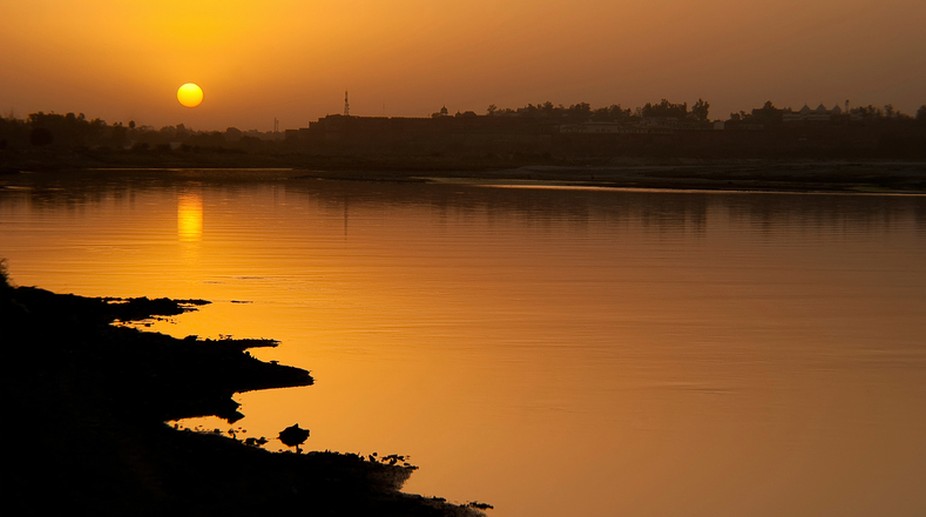UP: Three rescued, 3 missing during Ganesha idol immersion in Yamuna at Agra
Six people who had gone for Ganesha idol immersion drowned in the Yamuna River in Agra, an official statement said.

Yamuna River (Getty Images)
A dense smell of excrement attacks one's nostrils just before the rugged downslope that leads to the banks of the Yamuna river near Shastri Park metro station in northeast Delhi. If you stay there long enough, the stink seems to acquire stifling proportions in the 40 degree-plus temperature.
In the midst of this strip of fetid wasteland is located a rag-tag cluster of tenements inhabited by a several hundred people, including families with children. At some remove, there is a tiny temple, the only brick-and-mortar structure in the shanty — erected probably in the hope of divine redemption.
This slum, like all such located on the Yamuna floodplains, is vulnerable to submergence nearly every monsoon.
Advertisement
"Last time it (Yamuna) flooded was in 2013. We had to move up the 'pushta' (the stone embankment) and stay there for days until the water receded… Although during rainy season the water comes very near and submerges the nearest huts, it comes to flooding only in about three-four years," said Radheshyam, who has been living in Shastri Nagar Metro Depot Yamuna Khadar slums for 8-9 years, after he was shifted from a different slum which was razed in the run-up to the 2010 Commonwealth Games.
Coming from Gonda district in Uttar Pradesh to the capital in the hope of better means of livelihood, Radheshyam says that although he earns Rs. 300 or about every day, his condition is just as precarious.
"The government gives us nominal services– like a water tanker every day — but no permanency. There are 1,265 voters in these slums, but they are not good enough to be located at a better place," he adds resignedly.
The seasonal flooding poses a graver concern at the slums located on the other side of the road along the narrow river stretch where most of dwellers identify themselves as farmers.
"The rains don't affect us much but the floods ruin everything that we grow, which is mainly vegetables," says Ismail from Kisan Colony Yamuna Khadar, who has been living in the same slum since 1981 and runs an NGO there.
"We are farmers and almost everyone here is a Muslim. When the river flooded a few years back we were rushed up on the 'pushta'. We squatted there for 20 or so days before coming down and took stock of the mess," he says before showing off a madrassa (Islamic seminary) where "kids study and adults go to pray".
Asked how they prepare against such contingencies as floods, Ismail dismissed the question with a fatalistic shrug, saying they do nothing as there's nothing that can be done.
"A couple of years back government officials came and said that Yamuna is going to be cleaned up. They asked us to grow vegetables at our own risks since that can be destroyed whenever the cleaning starts.
"No one has come yet for the cleaning, it has been two years. But farming requires a lot of investment and I cannot risk that much money," he said.
A pair of girls smiled shyly when asked about their condition during floods. They said they just go "up the pushta".
The slum-dwellers, it was revealed, are not wholly on their own against floods. The local authorities also do their bit and provide for the shelter, sometimes food, and money, at least last time, to rebuild shanties.
"The police come to tell us two-three days before to evacuate," says Ismail, who now makes do by selling vegetables off-cart unlike before when he would sell them wholesale in the market.
Experts claim that the danger of floods has been on the increase with the rise of structures being built on the floodplains of the river.
The Art of Living festival last year on the flood plains was criticised by environmentalists and Yamuna conservation activists who had argued that the festival would harm the plains' capability of holding soil and recharging groundwater, leading to more frequent floods.
However, faced with a chronic threat, these slum-dwellers bear nature's annual challenge with remarkable fortitude and have learnt to live with it in the absence of any viable alternative.
The banality of even such grave poverty was manifest in Radheshyam's comments when, visibly tired of talking about floods, he said: "The biggest problem is mosquitoes, they don't let me sleep in night."
Advertisement